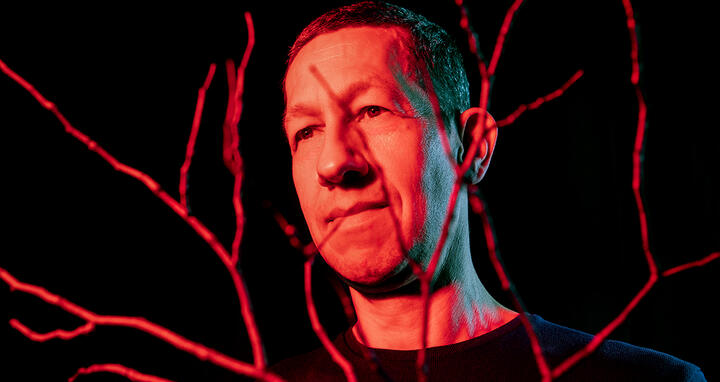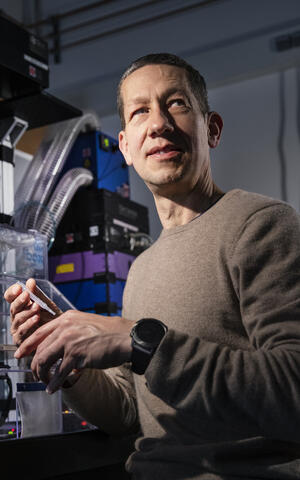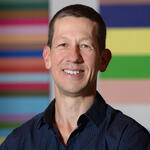When new blood vessels sprout
Sitting in his lab 20 years ago at the University of Gothenburg in Sweden, Holger Gerhardt had no idea he was about to make a major discovery. A 30-year-old postdoc at the Department of Medical Biochemistry, all he wanted to do was help a student who had just stained a sample. As he peered through the microscope at the retina cells of a mouse, however, he balked. He saw something no one had ever noticed before: long, threadlike growths developing at the tips of tiny capillaries.
Holger Gerhardt is head of lab "Integrative Vascular Biology" at the MDC.
The research project he had planned was on a totally different topic, but he immediately realized what he was seeing deserved a closer look. It paid off: that day he observed new blood vessels sprouting, and he went on to study how and why this phenomenon occurs. In 2011 his research won the Judah Folkman Award from the North American Vascular Biology Organization.
“Eureka moments like that are the best part of science,” comments Gerhardt, who is now an internationally renowned specialist on angiogenesis, the formation of new blood vessels. He is sitting at a small table in his office at the Max Delbrück Center for Molecular Medicine (MDC) at the Berlin-Buch campus. Ten minutes earlier he had bounded up the steps to the second floor with his bicycle, which is now propped against the wall next to his desk.
A maze of tubes
He logs many kilometers on his bike each week in Berlin, as he works at various locations around the city. In addition to the research group he directs at the MDC, he is also Professor of Experimental Cardiovascular Research at the Berlin Institute of Health (BIH), and he is involved in the German Center for Cardiovascular Research (DZHK). He not only conducts basic research but also collaborates closely with medical practitioners in hospitals. “There are hardly any diseases affecting our society in which blood vessels do not play a primary or secondary role,” says Gerhardt. This applies to cardiovascular diseases, but also to cancer, diabetes and dementia.
Blood vessels comprise a complex network of arteries, veins and capillaries that supply the body with nutrients and oxygen. A maze of tubes that can be thick as a thumb or thinner than a single hair. Gerhardt discovered that when new endothelial cells sprout from the wall of existing blood vessels, they take on various functions. “Tip cells” lead the way for the “stalk cells” that follow. The two kinds of cells move back and forth, trading places and functions and acting as if they were competing with one another. According to Gerhardt, “They exhibit a kind of social behavior.” Each one seems to want to be in charge.
In this way, wispy new capillaries are formed bit by bit and connected to the large network of existing blood vessels. Gerhardt and his team want to know how the shape and size of individual vessels are regulated in this vast system of tubes. How do cells decide whether to build new branches or to enlarge the circumference of blood vessels? How do malformations occur? How are they fixed?
An accidental explosion
Holger Gerhardt has always enjoyed asking questions. “Even as a child I was incredibly curious,” he remarks. More than anyone, it was his grandfather – a passionate amateur scientist who built his own telescopes and even traveled to distant lands to observe solar eclipses – who instilled in Gerhardt an early enthusiasm for the natural sciences. On hikes together through the northern Black Forest where he spent his early childhood, his grandfather could name every plant. As a boy, Holger Gerhardt set up a chemistry lab in the bathroom. One experiment involving black powder resulted in an accidental explosion.
After graduating from high school in Stuttgart, he worked for a while in a pharmaceutical lab engaged in making ceramics out of cattle bones in blast furnaces. Once when his department head was absent for four weeks, he sketched the test facility and, in collaboration with the workshop, made a model of it for a patent application. “I was 18, wore a lab coat, and had my own office.” Gerhardt laughs at the recollection. They would have liked to keep him, but he wanted to go to college.
Even as a child I was incredibly curious.
He studied biology at Darmstadt and Tübingen. A lecture on the topic of glial cells by his future doctoral advisor first got him interested in neurobiology. He went on to write his dissertation on the blood-brain barrier. During his four years as a postdoc at the University of Gothenburg, his two daughters were born. He then spent ten years at the London Research Institute, where he headed up a research group while at the same time directing a lab at the Vesalius Research Center at KU Leuven in Belgium.
Cancer cannot be starved
In 2014 he jumped at the opportunity to come to Berlin and work with clinicians on developing new concepts for the treatment of cardiovascular and other diseases. For example, one day it may be possible to prevent the premature breakdown of blood vessels that plays a role in dementia, and that often appears in conjunction with high blood pressure. “Many people take medication nowadays to lower high blood pressure,” says Gerhardt. “We’re asking, ‘How can we protect the blood vessels?’” One way may be to make them more resilient.
In the case of cancer, tumors also sprout new blood vessels in order to grow. In the 1970s, American cell biologist Judah Folkman rose to prominence with the idea of inhibiting the formation of new blood vessels in tumors with medication. The hope was that tumors could be starved by depriving them of nutrients and oxygen. Yet this hope proved false. Gerhardt explains, “Like a plant in a garden that doesn’t get watered, the tumors began to spread out” – the opposite of the desired outcome. What is more, “When you kill a tumor’s blood vessels, it becomes more difficult to infiltrate it with toxins.”
Today, therefore, researchers are taking a contrary approach: contemplating how to improve tumors’ blood vessels, which are weak by nature, so that medicines can be pumped into them more reliably. “All the therapeutics that have been deployed so far – chemotherapy, radiation therapy – work better when the blood vessels work better,” notes Gerhardt. Recent unpublished results from his lab also show how immunotherapy can be made more effective against cancer.
Open dialogue
Twenty-one scientists from Germany, the United States, Australia, France, Spain, Portugal, Serbia, Ecuador, and Japan work in Gerhardt’s research group at the MDC. As the director, he doesn’t want to play the big-shot professor who instills fear and awe in his staff. Openness and team spirit are important to him. “My people should feel comfortable offering constructive criticism during meetings,” he emphasizes. “It also ensures a higher quality of scientific research.” He wants his lab to provide them with the ideal conditions for articulating and pursuing their own ideas. “I always had a lot of freedom to pursue my own projects,” he says, adding that it helped make him an independent thinker.
Today Holger Gerhardt has almost no time to conduct his own experiments. “But it’s just as rewarding to see my team members make progress as it is to make my own discoveries,” he says. He does sometimes feel a tinge of jealousy, though. Back when he was a lab researcher, he would have loved to use the excellent equipment that is available now.
Alice Ahlers







